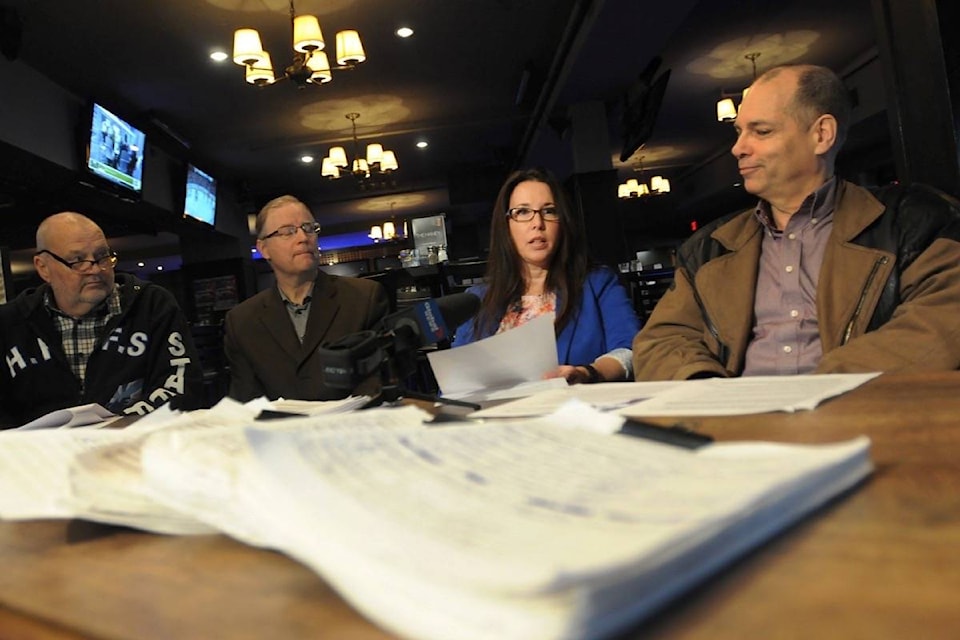Maple Ridge’s new shelter can’t be low-barrier and it can’t be in the downtown or on Lougheed Highway or Dewdney Trunk Road, according to the MLAs’ citizens’ advisory committee.
The group was named earlier this year by Liberal MLAs Doug Bing and Marc Dalton to find a location for a new $15-million homeless shelter and supportive housing complex that B.C. Housing is willing to build in Maple Ridge.
“I do think it reflects what people have said,” said Christine Bickle, who chaired the committee and works beside one of the former proposed locations.
The committee has also recommended a new location for the shelter to B.C. Housing, but that can’t be revealed yet.
Bickle said that no matter what the committee recommended, it would be criticized.
If B.C. Housing agrees with the new location, it will be forwarded to local MLAs “for decision” after the May 9 provincial election.
The committee released its report, sub-titled “The right model can go anywhere,” this past week so that it becomes part of the public record and so that people know it’s not being delayed until after the election.
“We really did put a lot of thought and effort into this,” Bickle said.
The committee, composed of seven Maple Ridge residents, was told by the incumbent MLAs to consider public opinion, such as two petitions totalling 16,000 names that opposed two previous locations for shelters – one at the Quality Inn, the other at 21375 Lougheed Hwy. – when making its recommendations.
B.C. Liberal leader Christy Clark said last September that the two MLAs would have the final say on where it will be built in Maple Ridge.
E-mails and phone calls, a rally against the Quality Inn and the MLAs forum in January were also considered, along with opinions sent in on comment cards from the MLAs’ forum and opinions expressed at coffee meetings.
A timeline for when a new shelter is actually built remains unclear, but Bickle expects the city to allow the public to have its say during any rezoning process.
“I just really hope that they allow the public a voice. People felt they were shut out,” from expressing their views when the two previous shelter locations were considered, she said Monday.
“This issue is much larger than campaign slogans and talking points,” Bickle added.
Former B.C. Housing executive-director Darin Froese said the location can’t be revealed because the prices could be inflated before it’s bought.
Rob Thiessen, CEO with Hope for Freedom Society, said what’s being recommended are common across B.C. Most shelters in B.C. have curfews. Some experts agree that low-barrier shelters, where people don’t have to be clean to stay at the shelter, can stay inside all day or use drugs, are one solution. There’s also a shortage of high-barrier, drug-free options for shelters.
“Things that occur in the Downtown Eastside don’t necessarily work here and we need to be sensitive to that.”
B.C. Housing, city council and residents will decide how the shelter operates, he added.
Dr. Paul Beckett, a former medical director at Maple Ridge Treatment Centre and Hannah House, and currently providing opioid-assisted therapy at Alouette Addictions Society, said there should be reasonable access to emergency services, an on-site medical office run by Fraser Health, along with an intensive case management team, that’s already in place.
Social, physical and mental health assessments must all be done when people are taken in.
It’s going to take time to digest the report, said Doug Bing, former MLA and Liberal candidate for Maple Ridge-Pitt Meadows.
“It’s very thoughtful,” Dalton said, adding it’s no easy task.
Other conditions of how the shelter will operate are also laid out. Residents will be offered case-management plans and won’t be considered permanent residents. Restorative justice will part of the program, as will be a curfew. There will be reasonable access to public transit, though the shelter will not be near residential areas.
“Crime that supports addiction will not be tolerated. Breeches in behaviour will result in removal from the facility,” says the report.
One member of the committee said that the terms low-barrier or high-barrier are confusing. Any shelter that takes in an addicted person has a low-barrier component, said one member of the committee.
Low-barrier means different things in different communities, added another.
Salvation Army shelters around B.C. have recently adopted low-barrier practices.
But community support is crucial because when local residents help out, that makes a difference to the residents.
Currently, the temporary homeless shelter on Lougheed Highway is in the process of being closed down, with about 30 of the 40 residents being moved to the Salvation Army Ridge Meadows Ministries shelter, where they’ll sleep on mats in the cafeteria for six months.
The temporary homeless shelter was only supposed to be open for six months when it opened in October 2015 to give people a place to go when the tent camp on Cliff Avenue was disbanded.
Maple Ridge Coun. Craig Speirs said a shelter has to be in the downtown so that people can access it.
“They’ll be wandering back and forth trying to get services and ending up in a hole.
“We have to have a way of bringing them in, not pushing them out. If we try to shun people, they react with anger. Why wouldn’t you be angry if you keep getting shunned?” Speirs asked.
“It’s love, inclusion and respect that gets people to change their ways.”
He said there should be two shelters, one for those trying to get clean and another for people still using drugs.
Shelters should also include a place nearby or inside for people to shoot up safely.
“It’s so dangerous these days. You can’t use alone. That killed my best friend’s son.”
People who are dying from fentanyl overdoses are recreational users, not addicts, he added.
“What they’re suggesting won’t work and they need to be shuffled off.”
